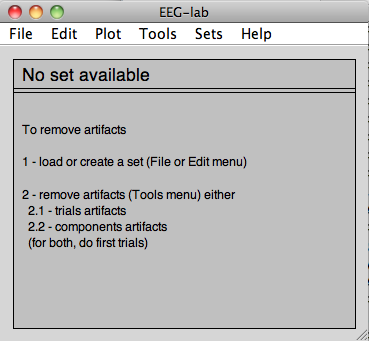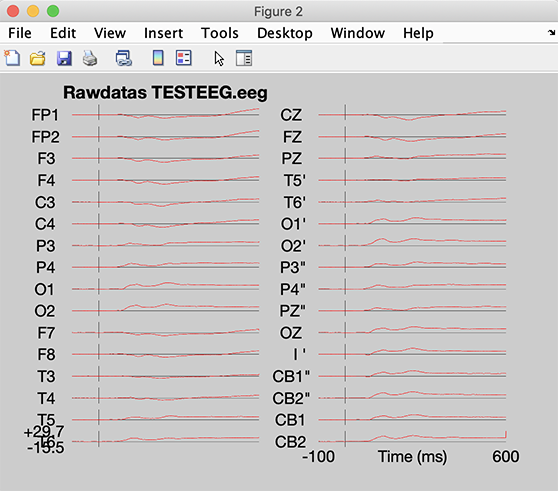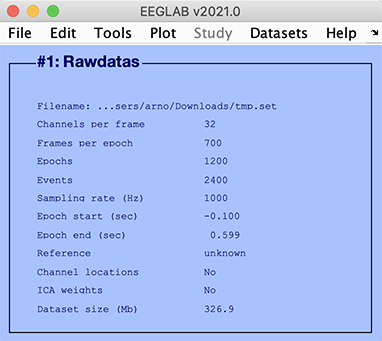The first two decades of EEGLAB
EEGLAB (v0.9) was first released on April 23, 2001 - thus, EEGLAB is now 20 years old!

A bit of history
In 1997, Scott Makeig, Tzyy Ping Jung, and colleagues released the ICA Electrophysiology Toolbox for MATLAB from Terrence Sejnowski’s CNL laboratory at The Salk Institute for Biological Studies in La Jolla. This toolbox comprised functions to run (extended) infomax ICA on EEG data as well as early versions of time/frequency and visualization functions used in EEGLAB including eegplot(), topoplot(), headplot(), envtopo(), timtopo(), and erpimage(). In 2000, Arnaud Delorme joined the Salk Institute and wrote the first version of EEGLAB to reject automatically (or semi-automatically) artifacts in EEG data. This version of EEGLAB used the ICA toolbox mentioned above for some of the data processing. We demonstrate below how the current version of EEGLAB remains backward compatible with this very early version of EEGLAB (v0.9). EEGLAB versions 1 and 2 followed. EEGLAB v2, released in 2002, implemented the EEGLAB history feature that users can use to generate EEGLAB scripts automatically. Scripts generated by this version are still compatible with the current EEGLAB version.
By 2001, the team of researchers working on EEG processing in Terrence Sejnowski’s CNL laboratory (including Dr. Delorme and Makeig) was becoming too large for the space available. Coincidentally, Dr. Jerome Swartz, an early inventor of laser barcoding, agreed to give funds to UCSD to create a research center dedicated to studies of higher-order human cognition using EEG. Based on the initiative of Terry Sejnowski, the Swartz Center for Computational Neuroscience (SCCN) was founded under the then-small Institute of Neural Computation at UCSD. Scott Makeig became the director of this new center, and Dr. Arnaud Delorme and other EEG researchers also moved from the Salk Institute to the new center.
At SCCN, command-line functions of the ICA Electrophysiology toolbox and the proto version of EEGLAB were fused. EEGLAB v3, an internal version, was never released. EEGLAB v4, the first integrated and fully functional version of EEGLAB, was released at the end of 2002.
Several revisions of EEGLAB v4 were released from 2003 to 2006, strengthening the code and adding capabilities for importing data in many different formats. In 2006, EEGLAB v5 was released, adding the STUDY structure and many functions giving EEGLAB users a pipeline for processing data from multiple subjects, including the first software for ICA component clustering.
In 2007, EEGLAB v6 was released, allowing users to perform statistical analyses at the STUDY level and use EEGLAB plugins.
In 2009, EEGLAB v7 was released under a new revision control system (migrated from RCS to CVS) that added consistency and reliability.
At the beginning of 2010, EEGLAB v8 was released, allowing access to single-trial subsets from STUDY functions.
At the end of 2018, a new version of EEGLAB was released that offered full support for single-trial analyses. This version also contained the EEGLAB plugin manager.
More details about each EEGLAB version is available on the EEGLAB revision page.
Statistics
The total number of lines of code (excluding plugins) is currently 145,271 comprising 636 stand-alone functions. Currently, there are 15,265 researchers on the EEGLAB news list. EEGLAB has been downloaded about 350,000 times. According to the ISI web of knowledge, the original 2004 EEGLAB paper has been cited 14,400 times.
EEGLAB is still backward compatible with EEGLAB v0.9
This section is just for fun! Below we illustrate how serious we are about backward compatibility, showing that files saved with EEGLAB v0.9 can still be read in EEGLAB version 2021.
You may download below the original files for the first version of EEGLAB released on April 23, 2001 (full instructions are also available on the original EEGLAB web page). Please download and uncompress the archives of the EEGLAB, the ICA toolbox, and the test file.
- eeglab0.9.tar.gz (< 1Mb)
- ica5.tar.gz (< 1Mb)
- TESTEEG.eeg (50 Mb)
Start MATLAB, add the path to each of the uncompressed folders, and type >>eeglab on the command line.

Then select the File → Load EEG menu item. Select the “TESTEEG.eeg” file you have downloaded. Be sure to change the default event type range from 12501:12600 to all, as shown in the image below.

EEGLAB loads the dataset and plots an ERP-image figure (it will also generate an error under MATLAB 2020a because of axes settings incompatibility - remember this version is 20 years old!). You may use Plot → average to pop up the plot below.

You may then save the dataset using the File → Save set menu item.
Then go back to your current version of EEGLAB: remove the paths to EEGLAB v0.9 and restart your current version of EEGLAB. Load and manipulate the dataset you have just saved in EEGLAB v0.9.

This exercise demonstrates how, since the beginning of EEGLAB, we have maintained backward compatibility between EEGLAB versions (supported by the relative stability of MATLAB itself).
Arnaud Delorme, January 6, 2021